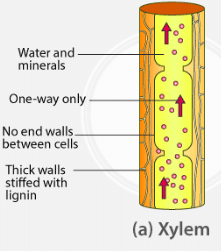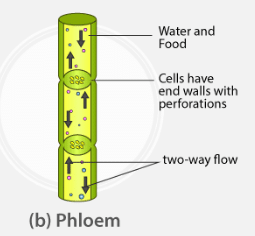Class 7 Exam > Class 7 Questions > What is xylem and phelom?
Start Learning for Free
What is xylem and phelom?
Verified Answer
What is xylem and phelom?

Xylem is one of the important tissues of the vascular system of plants. The main activity of this tissue is to transport minerals and water from roots and carry them to other parts of the plants. It has two separate chambers tracheids and vessels for transporting minerals and water. The term xylem is derived from the Greek word – ξύλον (xylon), meaning wood.

Phloem is also important as the xylem tissues for the vascular system of plants. The main activity of this tissue is to transport nutrients and food from leaves to other growing parts of plants. The term phloem is derived from the Greek word – φλοιός (phloios), meaning bark.
 This question is part of UPSC exam. View all Class 7 courses
This question is part of UPSC exam. View all Class 7 courses
Most Upvoted Answer
What is xylem and phelom?
Woody tissue that conduct water in plants is called xylem .And phloem tissue conduct food material in plants.
Community Answer
What is xylem and phelom?
Xylem and Phloem: The Transport Tissues in Plants
Plants are complex organisms that require an efficient transportation system to move water, nutrients, and other substances throughout their bodies. Xylem and phloem are two types of specialized tissues that play a crucial role in this process. They are responsible for the transport of water, minerals, sugars, and other organic compounds within a plant. Let's explore the structure and functions of xylem and phloem in detail.
Xylem:
Xylem is a complex tissue that transports water and dissolved minerals from the roots to the other parts of the plant, such as the stems and leaves. It consists of several types of cells, including tracheids, vessels, fibers, and parenchyma cells. Each cell type has a specific function in the transport process.
1. Tracheids: These are elongated, tube-like cells with tapered ends. They are the main conducting elements in most plants. Tracheids have thick, lignified cell walls that provide strength and support to the plant. Water moves through tracheids via pits, which are small openings in the cell walls that allow water to pass from one tracheid to another.
2. Vessels: Vessels are wider and shorter than tracheids. They are found in angiosperms, which are flowering plants. Similar to tracheids, vessels also have pits that facilitate the movement of water. The end walls of vessel elements are perforated or absent, forming continuous tubes for efficient water transport.
3. Fibers: These cells provide mechanical support to the xylem tissue. They have thick cell walls and are responsible for maintaining the structural integrity of the plant.
4. Parenchyma Cells: These are living cells that store food and water. They also provide support to the adjacent xylem elements.
Xylem transports water and minerals in a unidirectional manner, mainly through capillary action and the cohesion-tension theory. Capillary action is the movement of water through narrow spaces, such as the tracheids and vessels. The cohesion-tension theory explains how water is pulled up from the roots to the leaves due to the cohesive properties of water molecules and the transpiration pull.
Phloem:
Phloem is the other important transport tissue in plants, responsible for the movement of sugars, amino acids, hormones, and other organic compounds. It consists of four types of cells: sieve tube elements, companion cells, fibers, and parenchyma cells.
1. Sieve Tube Elements: These are elongated cells that form the main conducting elements of the phloem. They are arranged end-to-end to form sieve tubes. Sieve tube elements lack nuclei, making them dependent on companion cells for metabolic functions.
2. Companion Cells: Companion cells are intimately associated with sieve tube elements. They are responsible for providing energy and nutrients to the sieve tube elements, as well as assisting in the loading and unloading of substances into the phloem.
3. Fibers: Similar to xylem, phloem also contains fibers that provide mechanical support to the tissue.
4. Parenchyma Cells: These cells are involved in storage and support functions within the phloem.
Phloem transports organic compounds in a bidirectional manner, through a process called translocation. This process involves the active loading of sugars (
Plants are complex organisms that require an efficient transportation system to move water, nutrients, and other substances throughout their bodies. Xylem and phloem are two types of specialized tissues that play a crucial role in this process. They are responsible for the transport of water, minerals, sugars, and other organic compounds within a plant. Let's explore the structure and functions of xylem and phloem in detail.
Xylem:
Xylem is a complex tissue that transports water and dissolved minerals from the roots to the other parts of the plant, such as the stems and leaves. It consists of several types of cells, including tracheids, vessels, fibers, and parenchyma cells. Each cell type has a specific function in the transport process.
1. Tracheids: These are elongated, tube-like cells with tapered ends. They are the main conducting elements in most plants. Tracheids have thick, lignified cell walls that provide strength and support to the plant. Water moves through tracheids via pits, which are small openings in the cell walls that allow water to pass from one tracheid to another.
2. Vessels: Vessels are wider and shorter than tracheids. They are found in angiosperms, which are flowering plants. Similar to tracheids, vessels also have pits that facilitate the movement of water. The end walls of vessel elements are perforated or absent, forming continuous tubes for efficient water transport.
3. Fibers: These cells provide mechanical support to the xylem tissue. They have thick cell walls and are responsible for maintaining the structural integrity of the plant.
4. Parenchyma Cells: These are living cells that store food and water. They also provide support to the adjacent xylem elements.
Xylem transports water and minerals in a unidirectional manner, mainly through capillary action and the cohesion-tension theory. Capillary action is the movement of water through narrow spaces, such as the tracheids and vessels. The cohesion-tension theory explains how water is pulled up from the roots to the leaves due to the cohesive properties of water molecules and the transpiration pull.
Phloem:
Phloem is the other important transport tissue in plants, responsible for the movement of sugars, amino acids, hormones, and other organic compounds. It consists of four types of cells: sieve tube elements, companion cells, fibers, and parenchyma cells.
1. Sieve Tube Elements: These are elongated cells that form the main conducting elements of the phloem. They are arranged end-to-end to form sieve tubes. Sieve tube elements lack nuclei, making them dependent on companion cells for metabolic functions.
2. Companion Cells: Companion cells are intimately associated with sieve tube elements. They are responsible for providing energy and nutrients to the sieve tube elements, as well as assisting in the loading and unloading of substances into the phloem.
3. Fibers: Similar to xylem, phloem also contains fibers that provide mechanical support to the tissue.
4. Parenchyma Cells: These cells are involved in storage and support functions within the phloem.
Phloem transports organic compounds in a bidirectional manner, through a process called translocation. This process involves the active loading of sugars (
Attention Class 7 Students!
To make sure you are not studying endlessly, EduRev has designed Class 7 study material, with Structured Courses, Videos, & Test Series. Plus get personalized analysis, doubt solving and improvement plans to achieve a great score in Class 7.

|
Explore Courses for Class 7 exam
|

|
Similar Class 7 Doubts
What is xylem and phelom?
Question Description
What is xylem and phelom? for Class 7 2024 is part of Class 7 preparation. The Question and answers have been prepared according to the Class 7 exam syllabus. Information about What is xylem and phelom? covers all topics & solutions for Class 7 2024 Exam. Find important definitions, questions, meanings, examples, exercises and tests below for What is xylem and phelom?.
What is xylem and phelom? for Class 7 2024 is part of Class 7 preparation. The Question and answers have been prepared according to the Class 7 exam syllabus. Information about What is xylem and phelom? covers all topics & solutions for Class 7 2024 Exam. Find important definitions, questions, meanings, examples, exercises and tests below for What is xylem and phelom?.
Solutions for What is xylem and phelom? in English & in Hindi are available as part of our courses for Class 7.
Download more important topics, notes, lectures and mock test series for Class 7 Exam by signing up for free.
Here you can find the meaning of What is xylem and phelom? defined & explained in the simplest way possible. Besides giving the explanation of
What is xylem and phelom?, a detailed solution for What is xylem and phelom? has been provided alongside types of What is xylem and phelom? theory, EduRev gives you an
ample number of questions to practice What is xylem and phelom? tests, examples and also practice Class 7 tests.

|
Explore Courses for Class 7 exam
|

|
Suggested Free Tests
Signup for Free!
Signup to see your scores go up within 7 days! Learn & Practice with 1000+ FREE Notes, Videos & Tests.

























